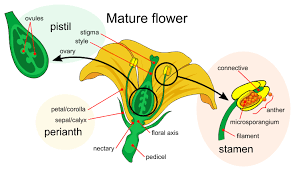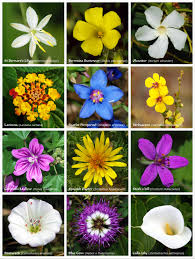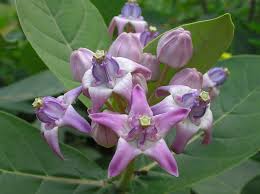MORPHOLOGY OF FLOWERING PLANTS
- Correct position of floral parts over thalamus in mustard plant is [NEET 2020]
(1) Gynoecium is situated in the center, and other parts of the flower are located at the rim of the thalamus, at the same level.
(2) Gynoecium occupies the highest position, while the other parts are situated below it.
(3) Margin of the thalamus grows upward, enclosing the ovary completely, and other parts arise below the ovary.
(4) Gynoecium is present in the center and other parts cover it partially.
2. The ovary is half inferior in: [NEET 2020]
(1) Mustard (2) Sunflower
(3) Plum (4) Brinjal
3. Ray florets have [NEET 2020]
(1) Superior ovary (2) Hypogynous
(3) Half inferior ovary (4) Inferior ovary
4. The body of the ovule is fused within the funicle at [NEET 2020]
(1) Micropyle (2) Nucellus
5. The roots that originate from the base of the stem are [NEET 2020]
(1) Primary roots (2) Prop roots
(3) Lateral roots (4) Fibrous roots
6. In some plants thalamus contributes to fruit formation. Such fruits are termed as:-[NEET 2020]
7. Diadelphous stamens are found in [NEET 2021]
(1) China rose and citrus
(2) China rose
(3) Citrus
(4) Pea
8. Persistent nucellus in the seed is known as [NEET 2019]
(1) Chalaza (2) Perisperm
(3) Hilum (4) Tegmen
9. Which of the following shows whorted phyllotaxy ? [NEET 2019]
(1) Calotropis (2) Mustard
(3) China rose (4) Alstonia
10. Placentation in which ovules develop on the inner wall of the ovary in peripheral part, is [NEET 2019]
(1) Basal (2) Axile
(3) Parietal (4) Free central
11. Bicarpellery ovary with obliquely placed septumis seen in:- [NEET 2019]
(1) Sesbania (2) Brassica
(3) Aloe (4) Solanum
12. Identify the correct feature of Mango and coconut fruits [NEET 2020]
(1) In both fruit is a drupe
(2) Endocarp is edible in both
(3) Mesocarp is coconut is fibrous and Mango is fleshy
(4) In both, fruit develops from monocarpellary ovary.
Select the correct option from below:-
(1) (i) and (ii) only (2) (i), (iii) and (iv) only
(3) (i), (ii) and (iii) only (4) (i) and (iv) only
13. Match the placenta types (column-I) with their examples (column-II) [NEET 2019]
Column-I Column- II
(a) Basal (i) Mustard
(b) Axile (ii) China rose
(c) Parietal (iii) Dianthus
(d) Free central (iv) Sunflower
Choose the correct answer from the following options:-
(1) (a)-(iii), (b)-(iv), (c)-(i), (d)-(ii)
(2) (a)-(ii), (b)-(iii), (c)-(iv), (d)-(i)
(3) (a)-(i), (b)-(ii), (c)-(iii), (d)-(iv)
(4) (a)-(iv), (b)-(iv), (c)-(i), (d)-(iii)
14. Coconut fruit is a [NEET 2017]
(1) Drupe (2) Berry
(3) Nut (4) Capsule
15. Root hairs develop from the region of [NEET 2017]
(1) Maturation (2) Elongation
(3) Root cap (4) Meristematic activity
16. The morphological nature of the edible part of coconut [NEET 2017]
(1) Perisperm (2) Cotyledon
(3) Endosperm (4) Pericarp
17. How many plants among Indigofera, Sesbania, Salvia, Allium, Aloe, mustard, groundnut, radish, gram and turnip have stamens with different lengths in their flowers? [NEET 2016]
(1) Three (2) Four
(3) Five (4) Six
18. Radial symmetry is found in the flowers of [NEET 2016]
(1) Brassica (2) Trifolium
(3) Pisum (4) Cassia
19. Pneumatophores occur in [NEET 2018]
(1) Halophtes (2) Free- floating hydrophytes
(3) Submerged hydrophytes (4) Carnivorous plants
20. Sweet potato is a modified [NEET 2018]
(1) Stem (2) Adventitious root
(3) Rhizome (4) Tap root
21. Free-central placentation is found in [NEET 2016]
(1) Dianthus (2) Argemone
(3) Brassica (4) Citrus
22. In Bougainvillea thorns are the modifications of [NEET 2017]
(1) Stipules (2) Adventitious
(3) Stem (4) Leaf
23. The term ‘polyadelphous’ is related to [NEET 2016]
(1) Gynoecium (2) Androecium
(3) Corolla (4) Calyx
24. The standard petal of a papilionaceous corolla is also called [NEET 2016]
(1) Corona (2) Carina
(3) Pappus (4) Vexillum
25. Tricarpellary, syncarpous gynoecium is found in flowers of [NEET 2016]
(1) Poaceae (2) Liliaceae
(3) Solanaceae (4) Fabaceae
26.. Stems modified into flat green organs performing the functions of leaves are known as [NEET 2016]
(1) Scales (2) Cladodes
(3) Phyllodes (4) Phylloclades
27. Match Column-I with Column-II and select the correct option using the codes given below:-[NEET 2016]
Column-I Column-II
a. pistils fused together (i) Gametogenesis
b. Formation of gametes (ii) Pistilate
c. Hyphae of higher Ascomcetes (iii) Syncarpous
d. Unisexual female flower (iv) Dikaryotic
Codes:-
(1) a(iv), b(iii), c(i), d(ii)
(2) a(ii), b(i), c(iv), d(iii)
(3) a(i), b(ii), c(iv), d(iii)
(4) a(iii), b(i), c(iv), d(ii)
28. Cotyledon of maize gain is called [NEET 2016]
(1) Scutellum (2) Plumule
(3) Coleorhiza (4) Coleoptile
29. Which of the following is not a stem modification? [NEET 2016]
(1) Flattened structure of Opuntia
(2) Pitcher of Nepenthes
(3) Thoms of citrus
(4) Tendrils of cucumber
30. Seed coat is not thin, membranous in [NEET 2013]
(1) Coconut (2) Groundnut
(3) Gram (4) Maize
ANSWER
1. (2) 2. (3) 3.(4) 4. (4) 5. (4) 6. (2) 7. (4) 8. (2) 9. (4) 10. (3)
11. (4) 12. (2) 13. (4) 14. (1) 15. (1) 16. (3) 17. (2) 18. (1) 19. (1) 20. (2)
21. (1) 22. (3) 23. (2) 24. (4) 25. (2) 26. (4) 27. (4) 28. (1) 29. (2) 30. (1)
QUOTE:- “IF YOU CANNOT DO GREAT THINGS
DO SMALL THINGS IN GREAT WAY”
Napoleon Hill



1 thought on “NEET CH-5 MORPHOLOGY OF FLOWERING PLANTS”